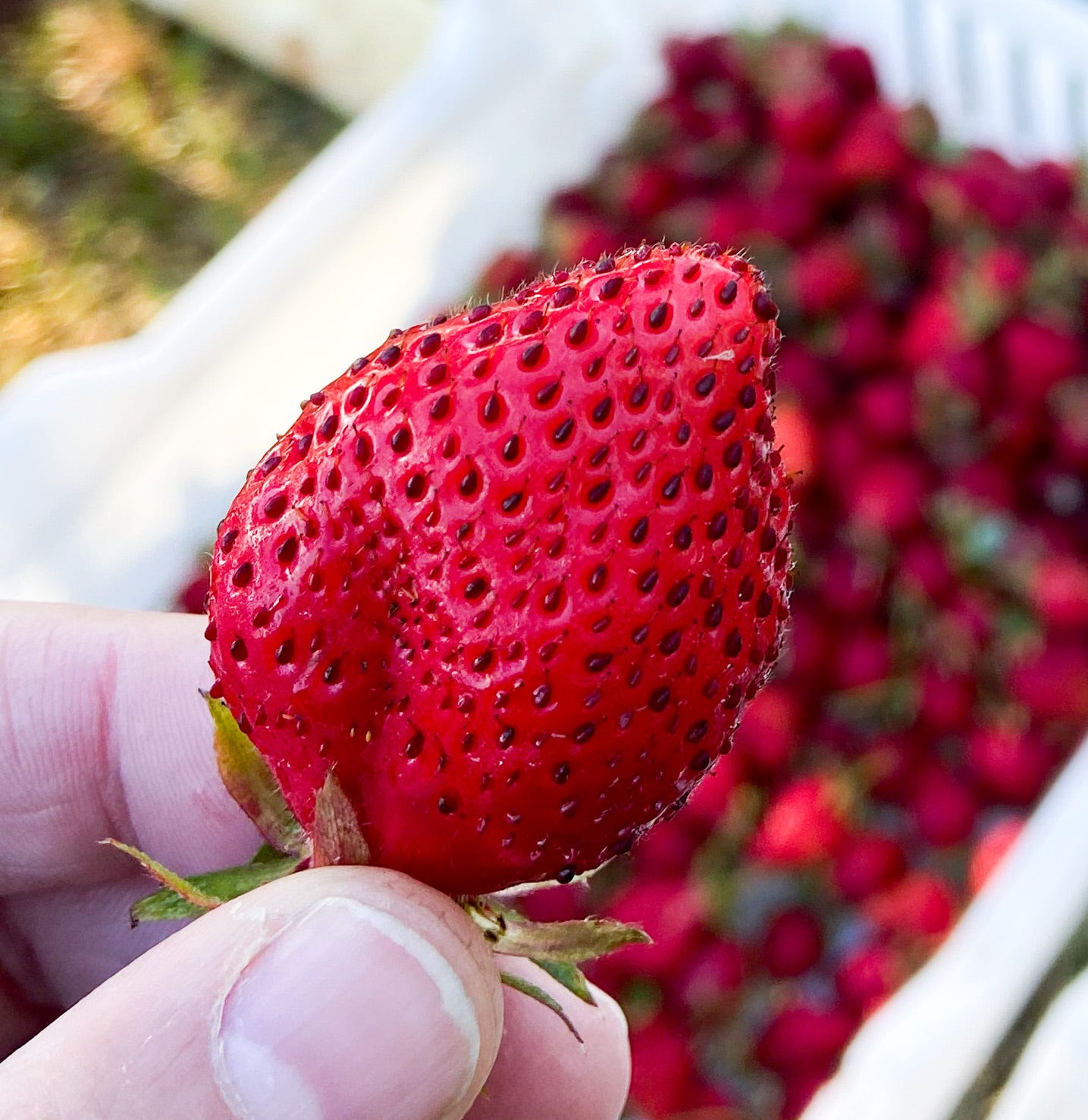Françoise says, “Galette”. Francesca says, “Crostata”. However you say it, it’s scrumptious. The fragole, aka strawberries, were bursting with cherubic jollyness at every mercato and I couldn’t help myself from snagging a few boxes for our dolce. Many of you may be old pros at making galettes by now, and a crostata is the Italian twin to our beloved French galette, so the method is identical. But, in case you’re new to this fruit-laden delight, stay with me here.
FIRST, make your crust:
Yields one 9" crostata, which can be sliced into 6-9 pieces
2 c all purpose flour, plus more for dusting
1 egg, lightly whisked
3 Tbs lard or duck fat, chilled and broken into small bits
3 Tbs chilled butter, unsalted, sliced into 3 pieces (if making dairy free, use all lard or duck fat OR.is only using butter, use 7 Tbs butter))
Cold water, about 1/4 - 1/2 cup
pinch of sea salt
1/4 c sugar
Pre-heat the oven to 400 degrees F
Assemble dry ingredients in a large bowl and, with a pastry cutter, a fork, or your hands, work the lard/ duck fat and butter into the flour until the pieces are incorporated. When you clump the flour mixture in your hand, it should hold form.
Drizzle in slowly 1/4 c of the cold water and stir with a fork until the dough comes together in a ball. Slowly add more water if it is too dry to stick together.
Pour out onto the floured counter and knead briefly to bring it into a ball shape.
Cover with plastic wrap or wax paper and put in the fridge for at least 20 minutes or up to overnight.
SECOND, whilst your dough chills, prepare your filling. Today we’re using strawberries, but the joy of this dish is that it is a delightful showcase for any fruit throughout the year. And if you have rhubarb, or blueberries, or other berries by all means add it to the mix!
Your fruit will cook down quite a bit, so you want enough to really create a heaping mound in your crostata. For an 8 to 9” size, I would recommend at least 2 1/2 to 3 pints of strawberries.
Cut off their greens and either half or quarter the berries depending on their size. You want them roughly the same size.
Place the cut berries into a bowl with enough sugar to just evenly coat them. Always taste the fruit before adding sugar because the sweetness of the berries will determine how much sugar you need. Just taste as you go and add more if need be. If you’ve accidentally added too much, just add more lemon or lime juice, or a splash of a mild vinegar like rice wine or champagne to balance it out. You can also add some finely ground chili for a little heat (like ancho or cayenne), which can be most enjoyable with strawberries.
Take your dough out of the fridge and roll it into the desired size. I start by gently patting it with the center of my rolling pin to flatten and push it outward, then make a quarter turn, and repeat until the dough is receptive to being rolled with the pin. It will tell you because it will start to expand more smoothly and rolling will become easier. You want it to be about 1/4 inch thick.
At this point you have a couple of choices (which you should actually make before this point, but oh well!). You can line an iron skillet with parchment and bake your crostata in there. You can use a pie pan. Or, you can use a lined sheet pan. The benefits of a sheet pan is that when there is the inevitable runoff of fruit juice, it won’t sit under your crust and make it soggy. But the other two help to hold the shape. I would use a sheet pan if I had the choice, just because strawberries are very juicy and tend to spill a lot of their liquid. But if I was using apples or something with less water, I would use the cast iron skillet to get a better crispy crust.
So, now that you know which item your crostata will bake in, move your dough over to it and you are going to build directly on it. To easily move the dough, fold it in half, then in half again and bring your pan right up next to it. Then quickly move and plop (technical term haha no, not really!) the dough to the center and unfold it.
Tip the fruit into the center and begin to fold the edges of the crust up and around until all of the fruit is secured. It’s like a free-form pie with a crust that grips onto the edges of the filling, rather than stand upright.
Use a pastry brush to put a light coat all over the pastry edges (or you can use an egg wash for this) and then sprinkle with some Demerera Sugar or Sugar in the Raw (big chunky sugar, that will keep a texture when baked) over the top of the pastry.
Bake until the crust is golden brown and the berries are bubbling, about 30 minutes.
Serve at room temp, gently dusted with powdered sugar and alongside some whipped cream, or honey-sweetened mascarpone with lemon zest if you so desire.


